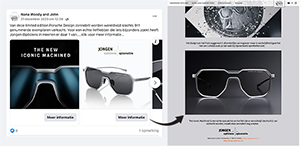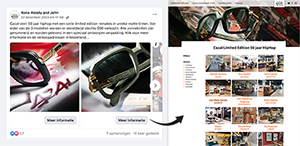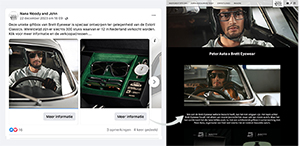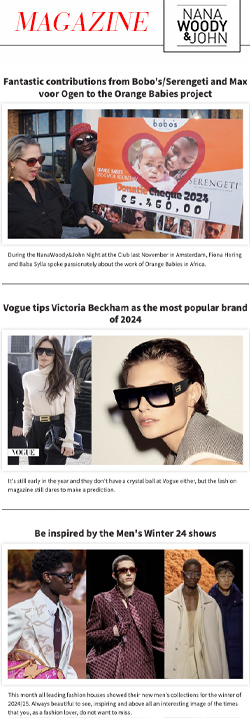SILMO 2016, CELEBRATING TECHNOLOGIES AND TRENDS
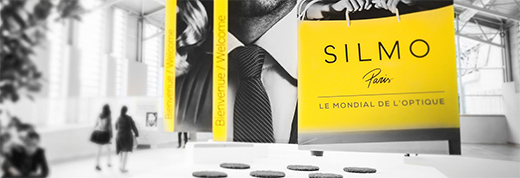
Characterised by a very positive business climate, the latest SILMO exhibition welcomed 33,771 visitors including 56.5% from abroad and 43.5% from France, demonstrating its attractiveness for everyone involved in the optics and eyewear sector.
Over the four days of the fair, the aisles were crammed with bustling stands and opticians captivated by stimulating products, all enhanced by the balmy atmosphere of the continuing Indian summer. Favourable weather reflecting a promising trade fair too!
As a platform t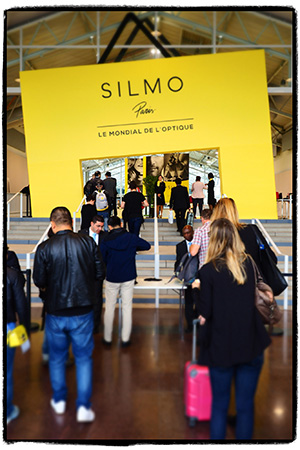 o launch dozens of brands and collections, but also a place to explore innovations, the MONDIAL DE L’OPTIQUE (World Optical Fair) showcased technologies and future trends. This edition was particularly notable for a proliferation of innovations combining the expertise of eyewear and lens manufacturers with new technologies. The focal points of the exhibition: customisation, support for visually impaired people and point-of-sale digitalisation… Not forgetting training in the form of the SILMO ACADEMY and a warm welcome for the opticians of tomorrow.
o launch dozens of brands and collections, but also a place to explore innovations, the MONDIAL DE L’OPTIQUE (World Optical Fair) showcased technologies and future trends. This edition was particularly notable for a proliferation of innovations combining the expertise of eyewear and lens manufacturers with new technologies. The focal points of the exhibition: customisation, support for visually impaired people and point-of-sale digitalisation… Not forgetting training in the form of the SILMO ACADEMY and a warm welcome for the opticians of tomorrow.
CLICK HERE FOR THE SILMO 2016 PICTURE GALLERY
CUSTOMISATION TREND
Customisation is a key consumption issue, irrespective of the actual product. In the optics sector, the MOF (Best Artisans in France) attending the exhibition demonstrated their virtuosity in working with horn and acetate, assisted by new technologies such as CAD vector drawing software. In the bespoke field, new players are making a valuable contribution. NETLOOKS (2016 Silmo d’Or award winner, Material/Equipment category) has developed a 3D software program that guarantees a perfect tailor-made product: a digital scan is taken of the wearer’s face using an optical system that creates an avatar by capturing thousands of data points; then with the optician’s assistance, it creates a customised frame by scrolling through thousands of combinations of faces, frame arms, colours, patterns etc., after which the glasses are manufactured in acetate in the traditional fashion in a Jura region workshop within two weeks. The new Yuniku concept by HOYA VISION CARE goes even further, outsourcing the entire printing process to its partners: Materialise and Hoet design studio.
With the help of the optician, a scanner creates a 3D model of the wearer’s face and calculates their visual requirements with extreme precision, then using a choice of frames (styles, colours and textures of materials) which are also 3D modelled, the software calculates the lens parameters based on the frame chosen, with an accuracy highlighting the inextricable links between all the various facets. Once the optician sends the order to Hoya, the glasses are delivered within 2 weeks.
LOW VISION TREND
Low vision is also at the forefront of research and development within the sector, with the development of remarkable (and remarked on) equipment. VISIOLE, a specialist in Braille and low vision products for visually impaired people, has created GoVison (2016 Silmo d’Or award, Low Vision category), a voice-activated TV enlarger that is exceptionally ergonomic and easy to use. The OrCam My Eye device from ESSILOR (2016 Silmo d’Or joint winner, Low Vision category) consists of a pair of glasses fitted with a miniature camera and speaker, with integrated software that reads text to a visually impaired wearer and can recognise people, objects, banknotes, etc. A wearable low vision device reminiscent of NuEyes, autonomous smart glasses developed by CECIAA (2016 Silmo d’Or joint winner, Low Vision category) which incorporate the functions of an electronic magnifier, reading unit, TV enlarger…
DIGITALISATION TREND
SILMO 2016 unveiled THE EXPERIENCE STORE, an area dedicated to digital solutions that create a brand new customer experience, enhancing the cross-channel and now interactive client-optician relationship. Designed around 6 points of contact — store window, reception, waiting area, shelf layout, measurement and tests, sales —, this digital pathway has highlighted the benefit of incorporating immersive technologies:
- Via the ACEP interactive touchscreen window display with dynamic functionality which grabs the attention of passers-by and presents a 24/7 personalised product offering.
- Via a holographic steward created by SEEDERTECH which interfaces with customers, facilitates information and prepares them for their meeting with the optician etc.
- Via the ELECOM touchscreen table which displays the store’s frame catalogue, provides additional information and helps streamline waiting times.
- Via the FITTING BOX virtual fitting room, which helps customers select in-store f rom an extended product catalogue.
- Via digital measuring and 3D sim ulations, offered by all lens manufacturers, which guarantees a high level of accuracy and reliability to customers.
- Via the M-Carte digital loyalty from LA COOPERATIVE DIGITALE – FUNFID which helps drive footfall and enhances the customer relationship.
CREATIVITY TREND
Creative diversity is at the heart of the exhibition with an optical frame and sunglasses offering of over 1,200 brands, illustrating the sector’s vitality. SILMO unveiled a selection of the very finest brands via two Pop-Up Stores — The Collectionist and The Selectionist — , a selection bolstered by the trends brought together in the digital magazine TRENDS by SILMO (available on the exhibition’s website), focused around five themes: Ultra Colours, No Gender, Cosmetic Touches, Gold Thread and Men in Stylish Fashion.
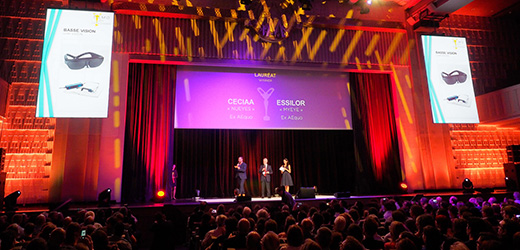
The 2016 SILMO D’OR awards dedicated to eyewear demonstrated the extent to which style combined with technical expertise highlights brand creativity.
- Frame Technological Innovation category: 77H by Exalto (Oxibis Group), which features a hinge comprising a ceramic compound, an ultra-functional, flexible hinge.
- Sport category: Lazer-Run by Demetz (Opal), a pair of glasses providing the opti on to fit three different optical solutions into a single frame; the first is a corrective optics kit, the second enables the optician to fit non-curved lenses and the third features curved lenses, enabling a 3-in-1 sports-eyewear product.
- Optical f rame category: The Khan by Blake Kuwahara, a concept whereby two completely separate frames are laminated together to create a frame within a frame.
- Sunglasses category: Anti RetroX by Parasite Design, a frame consisting of two materials, one using 3D printing, the other metal, creating a retro-futuristic design.
- Children’s category: Bili by Karavan Kids (KNCO), a frame especially designed for children aged 3 to 8 with a light acetate body and ultra-flexible surgical stainless steel arms without the need for hinges.
- Jury’s Award: M ask E3 by Kuboraum, a frame featuring drilled un worked lenses in to which acetate is inserted, to produce eye-catching glasses with porcelain nose-pads and adjustable sleeves.
A TRADE FAIR THAT SUPPORTS SCIENTISTS AND FUTURE PROFESSIONALS
Taking place under the MONDIAL DE L’OPTIQUE umbrella, SILMO ACADEMY certainly asserted its value, attracting a total of 425 participants over the three days of discussions. Attendees enjoyed the presentations by guest speakers including Professor Yves Pouliquen who is a member of the Académie Française, ophthalmologist Professor Christian Corbé and neurologist Dr Olivier Martinaud. With contributions from more than twenty specialists and renowned authorities, they explored the challenges inherent in sight and reading.
This 7th edition of SILMO ACADEMY also featured its first award of a €10,000 research grant to the IRIS neuroscience laboratory, within the CNRS (French National Centre for Scientific Research) at Paris Descartes University. The laboratory presented a project whose main aim is to study the interactions between ocular motricity, cognition and posture, taking into account inefficiency of plantar afferents. Zoï Kapoula, CNRS director of research at the IRIS laboratory who is working on Physiopathology of Binocular Vision and Motricity, highlights the fact that “on the one hand, this project will provide an important database into vergence efficiency and its role in postural control and cognition while on the other, it will help to measure the incidence of re-education in fields not yet fully understood by visual health professionals.
“The award of this €10,000 grant will play a role in developing the laboratory’s primary 2017 milestone, namely “a comparative study of students with binocular disorders in isolation, students with binocular disorders and foot inefficiency, versus students with foot inefficiency in isolation, versus control students without any disorder or inefficiency”.
By encouraging research into visual health, Silmo is also supporting future generations of opticians through its organisation, for the second time, of an inter-school contest. In a fun and festive ambience, 280 students and 8 high schools went head to head in the SILMO TV studio to win a trip to the Opti Trade Fair in Munich in January.
The winners of the study trip were the students of Lycée Victor Berard de Morez.
SAVE THE DATE FOR 2017!
On 6, 7, 8 and 9 October 2017, the next edition of SILMO will celebrate its 50th anniversary, where the focus will be on renewal, by enhancing its allure to host the sector’s finest trends and innovations, along with its best brands and companies.






